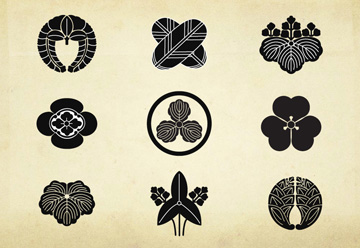Kamon
 Like family names which we naturally have, each Japanese family has its own kamon (crest). Kamon are like crests, and represents family trees or lineages. In other words, a kamon is common logo shared among family members. During the Heian Period (794-1185), aristocracies bore various logos on the bodies of gissha (cattle-drawn carriages) according to their tastes. Instead of their family names, these logos represented the ownership of the carriages. It is said that this custom represents the beginning of kamon.
Like family names which we naturally have, each Japanese family has its own kamon (crest). Kamon are like crests, and represents family trees or lineages. In other words, a kamon is common logo shared among family members. During the Heian Period (794-1185), aristocracies bore various logos on the bodies of gissha (cattle-drawn carriages) according to their tastes. Instead of their family names, these logos represented the ownership of the carriages. It is said that this custom represents the beginning of kamon.
Later in the warrior society, kamon became essential for samurai as they served as "banners" to distinguish friend or foe, and "brands" to appeal themselves to others. In the age of provincial wars (15-16 centuries), family kamon were segmentized and diversified into variations along with the increase of family quarrels. During this period, eye-catching and clear kamon were in the ascendancy, and the simple designs were preferred in order to be identified in battlefields.
In the Edo Period (1603-1868) known as a period of peace, kamon were no longer banners in battlefields, but became "authority symbols" representing family classes. Kamon were designed even based on small things such as clothes, panoplies and table ware. During this period, kamon gradually became graceful and sophisticated as their décorative aspect was more focused on. When the gorgeous chōnin (townsmen) culture was flowering at the end of the 17th century, kamon were also glamorously developed and became popular among ordinary people. At that time, ordinary people were not allowed to have family names and swords, but they could have their own kamon. However, ordinary people could not use same designs as samurai. Then, a variety of ingenious kamon designs were produced by ordinary people through modifying samurai kamon or creating original designs. Well-balanced symmetric designs, circled compositions…such kamon designs have been used up to the present. Kamon designs were diversified based on the free imagination of ordinary people at this time.
It is also said that the number of kamon is more than 20,000 as a wide variety of things in the universe are used as kamon designs. Representative kamon which are used by many families include wisteria, paulownia, creeping woodsorrel, hawk feathers, mokou* (the upper decorative parts of misu, bamboo curtains used for aristocratic houses), ivy, Sagittaria trifolia, daimyo oak, myoga, and citrus tachibana. These are called "the 10 most popular kamon," and except for the hawk feathers and mokou, other kamon are designed in the motif of flowers or leaves. Likewise, most kamon are designed using diverse things in nature such as the moon and stars, clouds and thunder, mountains and waves, animals and birds. Japanese people preferably use diverse things in nature for kamon as they respect nature and feel the joy of living in harmony with nature.
*Some people say that the mokou kamon was designed based on the cross-section of a cucumber as the same kanji characters were allocated for the name of this kamon.
Variously designed kamon making use of simple, elaborate, bold and delicate expressions are proud "Japanese designs" which incorporate Japanese aesthetics and ideas. In fact, during the Japonism that occurred in Europe at the end of the 19th century, kamon were highly evaluated as one of the Japanese fine arts and crafts including woodblock prints. It is said that the ideas, using familiar natural things, planar compositions, and simple designs, were accepted by European people as a new style, and kamon also inspired a lot of artists.
Nowadays, the opportunities to use kamon are mostly limited to ceremonial occasions, but it is hoped that this irreplaceable traditional culture created by Japanese people of times before will deeply be valued and taken over to future generations.
(Mitsuru Numata)










